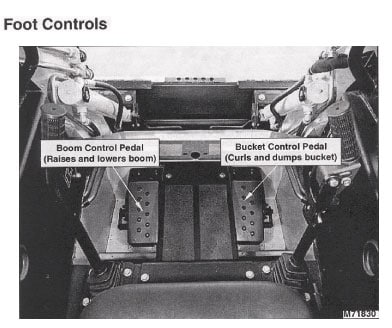Plant Production Supervisor Dies After Being Crushed Between the Boom Arm and Front Chassis of a Skid-Steer Loader – North Carolina
NIOSH In-house FACE Report 2000-15
Summary
A 41-year-old male plant production supervisor (the victim) died after being crushed between the left boom lift arm and the front chassis of a skid-steer loader (Photo 1). The skid-steer loader had been dropped off that morning by a rental agency representative who gave basic operating instructions to the victim and the plant maintenance supervisor. Later in the day the victim, who had been in the plant, was exiting the rear of the plant when he observed the maintenance supervisor having some difficulty operating the loader. The victim approached the loader to assist. The maintenance supervisor had no prior skid-steer loader experience and had been running the loader for approximately 10 to 15 minutes. He told the victim that he thought there was something wrong with the hydraulic system. Both men attempted to troubleshoot or identify the problem. The victim, who had some skid-steer loader experience and had been operating the loader earlier that morning, told the maintenance supervisor to raise the boom. While talking to the maintenance supervisor about a control handle on the right side of the operator’s seat, the victim moved under the boom’s lift arm to show him the control. Reaching across the front of the loader cab from left to right, the victim moved his arm to the right side of the maintenance supervisor, reaching for the auxiliary boom-control lever. From this point the exact sequence of events is not clear, however, for some reason the boom and bucket assembly came down rapidly on top of the victim, who was between the left boom lift arm and the front chassis of the loader. During the incident a hydraulic line ruptured at the elbow fitting on the left boom lift arm, spraying the maintenance supervisor and cab with hydraulic fluid.
Two witnesses rushed to the scene. The maintenance supervisor raised the boom and bucket assembly and the victim fell to the ground. He then moved the loader away from the victim and shut it down. Plant personnel arrived and began cardiopulmonary resuscitation (CPR) and called 911 for emergency assistance. Emergency response personnel arrived within minutes and continued CPR. The victim had sustained serious trauma to the head and chest and was pronounced dead at the scene. NIOSH investigators concluded that, to prevent similar occurrences, employers should:
- ensure that employees recognize the hazard of working under raised, unblocked machine components by providing appropriate training in the safe operation of all machinery and equipment
- carefully evaluate the knowledge and experience of their employees when choosing whether to rent equipment for them to use or to obtain the services of specialist contractors.
Additionally, rental agencies should
- ensure that customers are informed of safe operating procedures and proper use of equipment safety devices when machines are delivered.
Introduction
On March 3, 2000, a 41-year-old male plant production supervisor (the victim) died after being crushed between the boom arm and the front chassis of a skid-steer loader. On March 9, 2000, officials of the North Carolina Occupational Safety and Heath Administration (NCOSHA) notified the Division of Safety Research (DSR) of this fatality. On April 4-5, 2000, a DSR occupational safety and health specialist and a DSR safety engineer, accompanied by a compliance safety officer from the NCOSHA, conducted an investigation of the incident. A review was made of the incident scene photographs taken by the police department and the NCOSHA. The written police witness statements were also reviewed. The skid-steer loader was impounded after the incident and was not available for inspection during the investigation. However, the operation of a similar loader was observed at a local tractor-sales dealership. DSR investigators interviewed the plant manager where the incident occurred. The company had been manufacturing corrugated cardboard products since 1986 and employed approximately 90 people. There were a written comprehensive safety program, a 12-member safety council, and a safety awards program. The company conducted regular employee safety meetings. The victim was a plant production supervisor who had been with the company 6½ years. This was the company’s first occupational fatality.
Back to Top
Investigation
The plant management decided to put some sidewalks in the rear of the plant to connect a break and recreation area to the plant. Management, the plant production supervisor (the victim), and the maintenance supervisor agreed that construction costs could be reduced if a skid-steer loader were rented to prepare the construction site. At approximately 9:00 a.m. on the day of the incident, a loader was delivered to the plant by a rental company representative. After unloading the machine, the rental company representative gave instructions on basic operating procedures to the victim and the maintenance supervisor. The victim had some previous experience using skid-steer machines. He operated the loader for a short period, then went back into the plant. The maintenance supervisor had no prior experience operating a skid-steer loader.
At approximately 11:45 a.m., the maintenance supervisor began to operate the loader on a gravel-covered lot in the rear of the plant (Photo 2), to familiarize himself with the machine’s operation. The terrain was level and the weather was clear and dry. The maintenance supervisor had been operating the loader for about 10 minutes and thought that the machine was not performing properly. At this time, the victim was exiting the rear of the plant and observed the maintenance supervisor having some difficulty. He approached the loader and the maintenance supervisor told him he thought there was a hydraulic problem because the machine was operating too slowly. The victim told him to raise the boom and bucket assembly to its full height. The victim then moved under the boom and looked for any evidence of leaking hydraulic fluid. Seeing no leaks, the victim started talking to the maintenance supervisor about a control handle to the right side of the operator’s seat. There was some confusion between the two about which control handle they were talking about. The victim was standing under the left lift arm and reached across to the right of the operator’s seat and moved the auxiliary boom-control lever with his hand (Photo 3). At this point the maintenance supervisor said the main boom descended rapidly, pinning the victim between the left lift arm and the front chassis of the loader (Figure). Hydraulic fluid from a broken elbow fitting on the left lift arm started spraying all over the cab. Two contractors who witnessed the incident came over to help. The maintenance supervisor then raised the main boom and the victim fell to the ground. The operator backed the loader away from the victim and shut down the machine. Some employees came out of the plant to help. The victim was not moving and cardiopulmonary resuscitation (CPR) was attempted. Emergency responders had been called. The maintenance supervisor had been soaked with hydraulic fluid and was assisted back into the plant. Emergency responders arrived within minutes and continued CPR. Medical treatment was continued at the incident site, however, the victim sustained massive crushing injuries to the head and chest and was pronounced dead at the scene.
Back to Top
Cause of Death
The medical examiner listed the cause of death to be a result of blunt force trauma to the head and chest.
Recommendations and Discussion
Recommendation #1: Employers should ensure that employees recognize the hazard of working under raised, unblocked machine components by providing appropriate training in the safe operation of all machinery and equipment.
Discussion: The two supervisors did receive some basic operator training from the rental representative when the loader was dropped off. The plant production supervisor had some previous operator experience and the maintenance supervisor had none. The employer had no way of knowing the actual competence of either employee concerning the operation of a skid-steer loader. If employees are assigned to operate machinery/equipment, the training needs to be adequate to allow for safe operation. It would be prudent and is often required for employers to maintain a written or computerized record of employee training experience.
Training requirements are found in the specific sub-parts of the Code of Federal Regulations (CFR). The requirement for employees to be trained to recognize and avoid unsafe work conditions is found in 29 CFR 1926.21 (a) (2). Specific training standards and rules for rubber-tired skid-steer loaders, like the one involved in this incident, have not been proposed. However, the standard for Powered Industrial Trucks (29 CFR 1910.178) contains elements common to standardized safety training for a wide range of industrial vehicles. This standard requires demonstrated operator proficiency and may serve as a good training guideline to follow where formal standards are not yet available. These common safety elements include:
- Operating instructions, warnings, and precautions for the types of truck the operator will be authorized to operate.
- Differences between the truck and automobiles.
- Truck controls and instrumentation: where they are located, what they do, and how they work.
- Engine or motor operation.
- Steering and maneuvering.
- Visibility (including restrictions due to loading).
- Fork and attachment adaptation, operation, and use limitations.
- Truck capacity.
- Truck stability.
- Any inspection and maintenance that the operator will be required to perform.
- Refueling and /or charging and recharging batteries.
- Operating limitations.
- Any other instructions, warnings, or precautions listed in the operator’s manual for the types of industrial truck that the employee is being trained to operate.
The manufacturer’s operator’s manual may serve as an adequate training resource if it is thorough and well written. Additionally, some manufacturers and equipment dealers will provide trainers who can come on site to provide professional instruction to employee operators.
Employees should be given training to recognize the hazards associated with skid-steer operation, specifically performance hazards such as rollover, pinch points, and danger zones in and around operating equipment should be addressed in the training. Additionally, employees should be trained to recognize and avoid the hazards associated with raised booms, blades, buckets, forks, and hydraulic arms that are not properly blocked, locked out, or grounded while the machine is running or shut down.
Recommendation #2: Employers should carefully evaluate the knowledge and experience of their employees when choosing whether to rent equipment for them to use or obtain the services of specialist contractors.
Discussion: The maintenance supervisor and the victim had been given the task of constructing a walkway and picnic area for plant employees. Since the job was small, a decision was made to do the work using rented equipment and save the time and expense of contracting the work out to a construction firm. While the additional work needed to complete the project was not complicated, it was unlike anything the workers had previously encountered during the performance of their normal duties. Also, while the basic controls and operation of a skid-steer loader may not seem to be particularly complicated, it appears in retrospect that neither of the supervisors was fully aware of the characteristics and behavior of the machine. When it is necessary to conduct work tasks that are not within the workers’ range of duties, employers should carefully consider whether their employees have sufficient knowledge or experience to safely complete the task.
Recommendation #3: Rental agencies should ensure that customers are informed of safe operating procedures and proper use of equipment safety devices when machines are delivered.
Discussion: The maintenance supervisor had no experience operating skid-steer loaders. Reportedly, he had operated farm machinery. The victim had operated skid-steer loaders prior to the incident, but the extent of his experience is unknown. The loader in this incident was equipped with pin-type lift-arm stops activated by a control lever on the right side of the operator’s seat. When the lever is activated, a pin is extended from each side of the loader’s chassis, near the boom lift-arm pivots. After the pins are extended, the fully raised boom can be lowered to rest on the pins, protecting against lowering of the boom from loss of hydraulic pressure or inadvertent control activation. When the machine was delivered to the plant, the rental agency representative had explained the operating controls to both the maintenance supervisor and the victim. However, the maintenance supervisor stated that the lift-arm stops or their function had not been explained. It is not known if the victim had knowledge of the lift-arm stops or the hazard of moving under a raised unblocked boom. Knowledge of a machine’s safety devices does not guarantee proper use; however, if the maintenance supervisor had been informed of the lift-arm stops and the hazard of walking under raised unblocked equipment, he may have warned the victim to remain clear of the boom until it had been lowered or the lift-arm stops had been extended, and the incident would not have occurred. During the investigators’ visit to a local tractor sales dealership it was observed that at least one manufacturer provides a safe operation video tape with all their skid-steer loaders. Such a training aid, coupled with a review of the operator’s manual, may have helped to prevent this incident.
The investigators visited a local tractor sales company, and through the courtesy of the general manager, observed the operation of a loader similar to the one used in the incident. The operation and function of all foot (Photo 4a) and hand (Photo 4b) controls were demonstrated to the investigators while the loader was running. The left foot peddle operates the up-and-down movement of the boom lift arms. The right foot peddle operates the bucket assembly from the full-scoop-up position to the full-down or dump position. There are right and left control levers that resemble joy sticks. They control forward, reverse and the turning movements of the skid-steer vehicle. A two-position hand grip on the top of the right control lever operates the left and right hydraulic couplers and allows the operator to use auxiliary boom equipment such as a post hole digger, if attached. If placed in the full-down position toward the operators seat it provides hydraulic oil to operate the auxiliary equipment. In the full-up position it will reverse the flow of hydraulic oil away from the auxiliary coupler. The control handle should be locked in the center-neutral position when not in use to prevent overheating of hydraulic oil. The throttle is to be fully open when operating the machine. It was noted in the operator’s manual that if the throttle is not in the full open position the loader will operate more slowly. This may explain the perceived slow operation by the maintenance supervisor. There is a parking brake lever to the right of the operator’s seat. The operator’s manual states “Before you work on the loader or any attached equipment: lower attachments to the ground, or rest the lift arms on the lift-arm stops.” There is a lift-arm stop control lever that can be activated from the operator’s seat to deploy the lift-arm stops. Once deployed the boom can be lowered to rest the lift arms on the stops. These stops prevent the boom from inadvertently being lowered and allow for maintenance access to the underside of the boom.
Reference
Code of Federal Regulations 29 CFR 1926.602 (c) (2), 1999 edition. U.S. Government Printing Office, Office of the Federal Register, Washington, D.C.
Investigator Information
This investigation was conducted by Paul H. Moore, Safety Engineer, and Greg J. Smith, Occupational Safety and Health Specialist, Fatality Assessment and Control Evaluation Team, Surveillance and Field Investigations Branch, Division of Safety Research.
Back to Top
Photographs
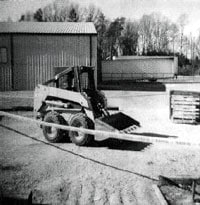
|

|
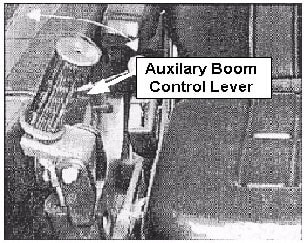
|
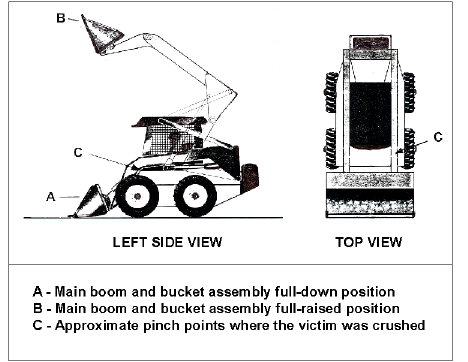
|
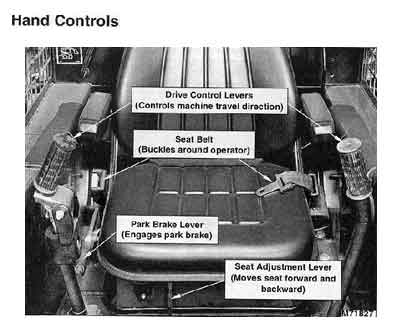
|
|
Photo 4a and 4b. Foot and Hand Controls
|
The FACE investigation project is the cornerstone of the overall NIOSH program to prevent occupational fatalities. The objectives for this effort include the investigation of occupational fatalities to assess and characterize the circumstances of these events in order to develop succinct descriptive and evaluative reports for distribution to occupational safety and health groups across the country. This work is being conducted by the FACE investigation team. It is expected that the reports alone will have a major impact by better defining the causal factors behind occupational fatalities, calling national attention to the problem, and providing insights into the prevention efforts that are needed. However, the program does not determine fault or place blame on companies or individual workers.

